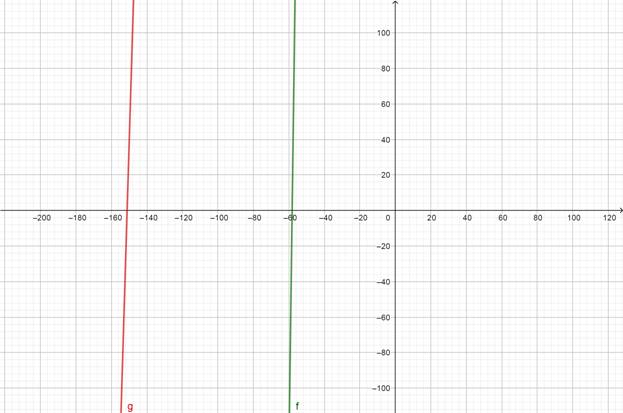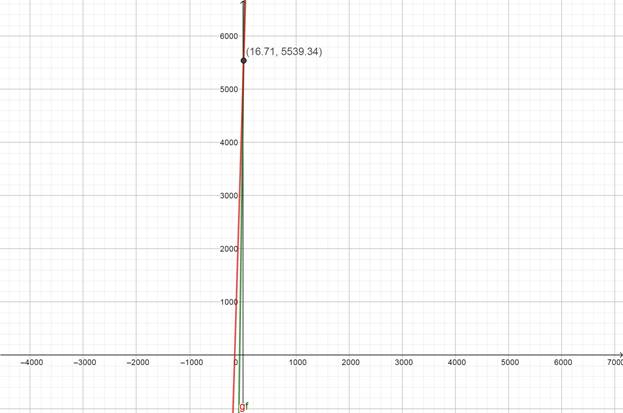
Concept explainers
To calculate the populations of Colorado C and Minnesota M from the year 2013 to 2020 modeled by the equations:
Answer to Problem 89E
From the years 2017 to 2020, the population in Colorado C is greater than the population in Minnesota M and the estimated point of intersection is
Explanation of Solution
Given information: The population models of Colorado C and Minnesota M from the year 2008 to 2012 is given as:
Where,
Calculation:
(a) Using the table feature in the utility to find the population of ColoradoC and Minnesota M from the year 2012 to 2020 is given in the following table:
| Year | |||
| 2008 | 8 | 4895 | 5252 |
| 2009 | 9 | 4969 | 5285 |
| 2010 | 10 | 5043 | 5318 |
| 2011 | 11 | 5117 | 5351 |
| 2012 | 12 | 5191 | 5384 |
| 2013 | 13 | 5265 | 5417 |
| 2014 | 14 | 5339 | 5450 |
| 2015 | 15 | 5413 | 5483 |
| 2016 | 16 | 5487 | 5516 |
| 2017 | 17 | 5561 | 5549 |
| 2018 | 18 | 5635 | 5582 |
| 2019 | 19 | 5709 | 5615 |
| 2020 | 20 | 5783 | 5648 |
(b) From the above table, it is concluded that in the years 2017, 2018, 2019 and 2020, the population in ColoradoC is greater than the population in Minnesota M
(c)Using the graphical utility to sketch the graph of the following functions:
Enter the expressions
The graph is :

The estimated point of intersection is:

From the above graph it is concluded that the estimated point of intersection is t = 16.71=~17
(d) The algebraic solution of the given equation:
To find the point of intersection, consider that
(e) From the part(b), part(c) and part(d), it is concluded that the years from 2017 to 2020, the population in Colorado C is greater than the population in Minnesota M and the solution of the given equations are the point of intersection, which is approximately
Chapter 7 Solutions
Precalculus with Limits: A Graphing Approach
- Consider the function f(x) = x²-1. (a) Find the instantaneous rate of change of f(x) at x=1 using the definition of the derivative. Show all your steps clearly. (b) Sketch the graph of f(x) around x = 1. Draw the secant line passing through the points on the graph where x 1 and x-> 1+h (for a small positive value of h, illustrate conceptually). Then, draw the tangent line to the graph at x=1. Explain how the slope of the tangent line relates to the value you found in part (a). (c) In a few sentences, explain what the instantaneous rate of change of f(x) at x = 1 represents in the context of the graph of f(x). How does the rate of change of this function vary at different points?arrow_forward1. The graph of ƒ is given. Use the graph to evaluate each of the following values. If a value does not exist, state that fact. и (a) f'(-5) (b) f'(-3) (c) f'(0) (d) f'(5) 2. Find an equation of the tangent line to the graph of y = g(x) at x = 5 if g(5) = −3 and g'(5) = 4. - 3. If an equation of the tangent line to the graph of y = f(x) at the point where x 2 is y = 4x — 5, find ƒ(2) and f'(2).arrow_forwardDoes the series converge or divergearrow_forward
- Suppose that a particle moves along a straight line with velocity v (t) = 62t, where 0 < t <3 (v(t) in meters per second, t in seconds). Find the displacement d (t) at time t and the displacement up to t = 3. d(t) ds = ["v (s) da = { The displacement up to t = 3 is d(3)- meters.arrow_forwardLet f (x) = x², a 3, and b = = 4. Answer exactly. a. Find the average value fave of f between a and b. fave b. Find a point c where f (c) = fave. Enter only one of the possible values for c. c=arrow_forwardplease do Q3arrow_forward
- Use the properties of logarithms, given that In(2) = 0.6931 and In(3) = 1.0986, to approximate the logarithm. Use a calculator to confirm your approximations. (Round your answers to four decimal places.) (a) In(0.75) (b) In(24) (c) In(18) 1 (d) In ≈ 2 72arrow_forwardFind the indefinite integral. (Remember the constant of integration.) √tan(8x) tan(8x) sec²(8x) dxarrow_forwardFind the indefinite integral by making a change of variables. (Remember the constant of integration.) √(x+4) 4)√6-x dxarrow_forward
 Calculus: Early TranscendentalsCalculusISBN:9781285741550Author:James StewartPublisher:Cengage Learning
Calculus: Early TranscendentalsCalculusISBN:9781285741550Author:James StewartPublisher:Cengage Learning Thomas' Calculus (14th Edition)CalculusISBN:9780134438986Author:Joel R. Hass, Christopher E. Heil, Maurice D. WeirPublisher:PEARSON
Thomas' Calculus (14th Edition)CalculusISBN:9780134438986Author:Joel R. Hass, Christopher E. Heil, Maurice D. WeirPublisher:PEARSON Calculus: Early Transcendentals (3rd Edition)CalculusISBN:9780134763644Author:William L. Briggs, Lyle Cochran, Bernard Gillett, Eric SchulzPublisher:PEARSON
Calculus: Early Transcendentals (3rd Edition)CalculusISBN:9780134763644Author:William L. Briggs, Lyle Cochran, Bernard Gillett, Eric SchulzPublisher:PEARSON Calculus: Early TranscendentalsCalculusISBN:9781319050740Author:Jon Rogawski, Colin Adams, Robert FranzosaPublisher:W. H. Freeman
Calculus: Early TranscendentalsCalculusISBN:9781319050740Author:Jon Rogawski, Colin Adams, Robert FranzosaPublisher:W. H. Freeman
 Calculus: Early Transcendental FunctionsCalculusISBN:9781337552516Author:Ron Larson, Bruce H. EdwardsPublisher:Cengage Learning
Calculus: Early Transcendental FunctionsCalculusISBN:9781337552516Author:Ron Larson, Bruce H. EdwardsPublisher:Cengage Learning





